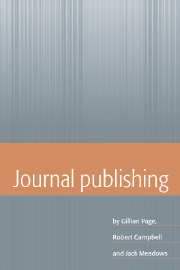Book contents
- Frontmatter
- Contents
- List of figures
- List of tables
- Preface
- 1 Introduction to journals
- 2 Editing
- 3 Production
- 4 Marketing
- 5 Subscription management and distribution
- 6 Non-subscription revenue
- 7 Legal and ethical aspects
- 8 Financial aspects
- 9 Bibliographic aspects
- 10 Managing a list of journals
- 11 Electronic publishing
- Appendix 1 Getting tenders for journals
- Appendix 2 Publishers' and editors' associations
- Glossary
- Bibliography
- Index
1 - Introduction to journals
Published online by Cambridge University Press: 23 October 2009
- Frontmatter
- Contents
- List of figures
- List of tables
- Preface
- 1 Introduction to journals
- 2 Editing
- 3 Production
- 4 Marketing
- 5 Subscription management and distribution
- 6 Non-subscription revenue
- 7 Legal and ethical aspects
- 8 Financial aspects
- 9 Bibliographic aspects
- 10 Managing a list of journals
- 11 Electronic publishing
- Appendix 1 Getting tenders for journals
- Appendix 2 Publishers' and editors' associations
- Glossary
- Bibliography
- Index
Summary
What is a journal?
The Oxford English Dictionary does not recognise the word ‘journal’ in the sense we use it in this book. It informs us - as would many librarians - that we should be using either ‘periodical’ or ‘serial’. Definitions vary, but librarians - the people most concerned with these divisions - would generally accept something like the following specifications:
Serial: a publication issued in successive parts, bearing numerical or chronological designations and intended to be continued indefinitely.
Periodical: a publication appearing at stated intervals, each number of which contains a variety of original articles by different authors.
Our main concern in this book is with learned (sometimes referred to as ‘scholarly’) journals. These are periodicals, or serials, which contain a significant proportion of articles (often called ‘papers’ in scientific journals) based on original scholarship - sometimes referred to as ‘primary ‘communications’. From the readers’ viewpoint, such journals blur with other types of serial. Singleton examined the holdings list of a large scientific research library and found that half of all the serials it acquired were not learned journals in terms of the definition given above (see Curwen, 1980). However, in terms of information handling, it is useful to treat ‘journals’ as a specific group, distinguished by the fact that the input of material to a journal is not usually predetermined. This contrasts with magazines, such as New Scientist or annual review volumes, where nearly all the material is commissioned (or written in-house).
- Type
- Chapter
- Information
- Journal Publishing , pp. 1 - 32Publisher: Cambridge University PressPrint publication year: 1997

